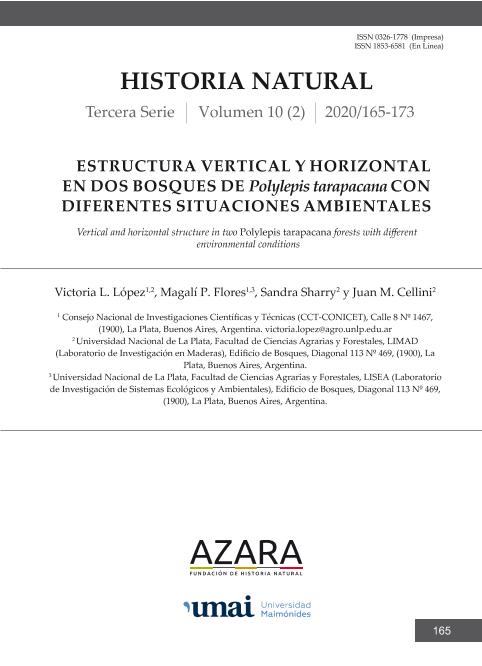Artículo
En la Provincia fitogeográfica Altoandina en Salta y Jujuy, la vegetación es estructuralmente homogénea y poco diversa, donde la queñoa, Polylepis tarapacana, es la única especie que presenta porte arbóreo. Identificar los cambios en la composición y estructura forestal es importante para conocer cómo estos bosques responden a gradientes ambientales, lo cual puede ser útil para plantear estrategias de restauración y conservación de la biodiversidad, entre otras cosas. Se comparó la estructura vertical y horizontal en dos bosques de P. tarapacana en Granadas (G) a 4747,6 ms.n.m y Laguna Larga (LL) a 4610,9 ms.n.m en Jujuy, Argentina. Los resultados sugieren una mayor ocupación y desarrollo del sitio G en relación a LL. Para los sitios estudiados, un aumento en la altura promedio de árboles presentó una relación positiva con la densidad, manteniendo el porcentaje de renovales similar en ambas zonas (735 n.ha-1 en G y 731 n.ha-1 en LL). Ambos sitios mostraron gran cantidad de suelo desnudo y rocas. Es necesaria la continuación de estudios sobre la estructura de estos bosques y su relación con características ambientales, para comenzar a entender su ecología. In the Altoandina phytogeographic province in Salta and Jujuy vegetation is structurally homogeneous and low diverse; the queñoa, Polylepis tarapacana, is the only species that presents arboreal size. Identifying changes in forest composition and structure is important to know how they respond to environmental gradients, which may be useful to set restoration and biodiversity conservation strategies, between other things. In this study, vertical and horizontal structure is compared in two forests of P. tarapacana with contrasting environmental differences in an environmental gradient. Plots were installed in Granadas (G) at 4747.6 masl and Laguna Larga (LL) at 4610.9 masl in Jujuy, Argentina, with contrasting environmental differences where the vertical and horizontal structure were surveyed, presenting values that suggest a greater occupation and development of site G in relation to LL. For the studied sites, an increase in average tree height shows a positive relationship with density, maintaining the similar percentage of renewals in both zones (735 n.ha-1 in G and 731 n.ha-1 in LL). Both sites show a high percentage of bare soil and rocks. It is necessary to continue studies on the structure of these forests and their relationship with environmental characteristics, in order to begin to understand their ecology.
Estructura vertical y horizontal en dos bosques de Polylepis tarapacana con diferentes situaciones ambientales
Título:
Vertical and horizontal structure in two Polylepis tarapacana forests with different environmental conditions
Fecha de publicación:
09/2020
Editorial:
Universidad Maimónides. Departamento de Ciencias Naturales y Antropología. Universidad Maimónides. Instituto Superior de Investigaciones. Centro de Estudios Biomédicos, Biotecnológicos, Ambientales y Diagnóstico. Fundación de Historia Natural Félix de Azara
Revista:
Historia Natural
ISSN:
0326-1778
e-ISSN:
1853-6581
Idioma:
Español
Tipo de recurso:
Artículo publicado
Clasificación temática:
Resumen
Palabras clave:
Estructura forestal
,
Sotobosque
,
Queñoa
,
Altoandina
Archivos asociados
Licencia
Identificadores
Colecciones
Articulos(CCT - LA PLATA)
Articulos de CTRO.CIENTIFICO TECNOL.CONICET - LA PLATA
Articulos de CTRO.CIENTIFICO TECNOL.CONICET - LA PLATA
Citación
Lopez, Victoria Lien; Pérez Flores, Magalí; Sharry, Sandra Elizabeth; Cellini, Juan Manuel; Estructura vertical y horizontal en dos bosques de Polylepis tarapacana con diferentes situaciones ambientales; Universidad Maimónides. Departamento de Ciencias Naturales y Antropología. Universidad Maimónides. Instituto Superior de Investigaciones. Centro de Estudios Biomédicos, Biotecnológicos, Ambientales y Diagnóstico. Fundación de Historia Natural Félix de Azara; Historia Natural; 10; 2; 9-2020; 165-173
Compartir




